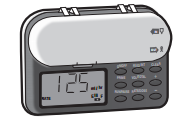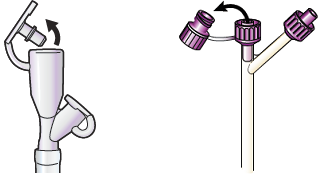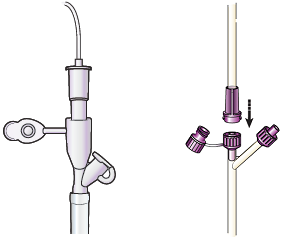What is a Tube Feeding Simulator
Tube Feeding With a Pump
Time to Read: About 9 minutes
This information will teach you how to use a pump to feed yourself and take your medications through your feeding tube. This includes percutaneous endoscopic gastrostomy (PEG), gastrostomy tubes (GT), nasogastric tubes (NGT), percutaneous endoscopic jejunostomy tubes (PEJ), jejunostomy tubes (JT), nasoduodenal tubes (NDT), and nasojejunal tubes (NJT).
Back to topAbout Tube Feeding
Tube feeding is when you get your nutrients through a feeding tube if you aren't able to get enough through eating and drinking, or if you can't swallow safely. Nutrients provide energy and help you heal. For more information about your feeding tube, including how to manage side effects, read Tube Feeding Troubleshooting Guide.
You may have a feeding tube with a legacy connector or an ENFit connector. In this resource, we'll show images of both types of connectors.
Types of tube feeding pumps

Figure 1. Portable pump
You'll be using a portable pump for your tube feedings (see Figure 1). There are 2 different kinds of pump feedings:
- Continuous feeding: This is when your tube feedings run continuously over 24 hours.
- Cycled feeding: This is when your tube feedings run for part of the day.
Your healthcare team will decide if continuous or cycled feeding is best for you.
If you're tube feeding into your small intestine (duodenum or jejunum), don't infuse formula faster than 150 milliliter (mL) per hour through your feeding pump. Your healthcare provider will let you know what you need to do.
Back to topTube Feeding Guidelines
Your clinical dietitian nutritionist will talk with you about your daily nutrition and hydration goals. Follow their recommendations. In addition to your formula, you can take water through your feeding tube. If you're admitted to the hospital, bring your button adapter with you, if you have one.
Back to topTube Feeding Instructions
Follow the steps in this section during your tube feeding. Read How to Prevent Aspiration before tube feeding to learn how to avoid having your formula go down your airway.
- Clean your hands.
- If you're washing your hands with soap and water, wet your hands, apply soap, rub them together thoroughly for at least 20 seconds, then rinse. Dry your hands with a towel and use that same towel to turn off the faucet.
- If you're using an alcohol-based hand sanitizer, be sure to cover all of your hands with it, rubbing them together until they're dry.
- Gather your supplies in a clean and comfortable place. Don't set up or do your tube feeding in the bathroom. You'll need:
- The amount of formula prescribed by your healthcare provider
- Your pump attached to an IV pole or in a backpack
- A pump feeding bag
- A cup
- A clean cloth or paper towel
- A container of water. You can use tap water as long as it's safe to drink.
- A 60 milliliter (mL) legacy catheter tip or ENFit syringe
- Tape
- A button adapter, if you have a button (see Figure 2) instead of a tube (see Figure 3).

Figure 2.
Button
Figure 3. Legacy gastrostomy tube (left) and ENFit (right)
- Close the roller clamp on the feeding bag (see Figure 4).

Figure 4. Close the roller clamp
- Wipe the top of the formula can with a clean cloth or paper towel. Pour the prescribed amount of formula into the feeding bag (see Figure 5).
- The bag will only hold 1,000 mL (4 cans) at a time. If you run the feeding throughout the day or night, pour in 6 to 8 hours worth of formula per feeding at a time. For example, if your tube feeding rate is 120 mL per hour, then you're infusing 1 can every 2 hours and you can fill the bag with 3 to 4 cans at a time.

Figure 5. Fill the feeding bag
- The bag will only hold 1,000 mL (4 cans) at a time. If you run the feeding throughout the day or night, pour in 6 to 8 hours worth of formula per feeding at a time. For example, if your tube feeding rate is 120 mL per hour, then you're infusing 1 can every 2 hours and you can fill the bag with 3 to 4 cans at a time.
- Hang the feeding bag 2 to 3 feet (.6 to .9 meters) above you on either an IV pole or hook (see Figure 6). It should be close to a comfortable chair or your bed.

Figure 6. Hang the feeding bag
- Hold the end of the feeding bag tube over a cup. Remove the cap at the end of the tube. Slowly open the roller clamp on the feeding bag tube (see Figure 7). Allow the formula to run through the tubing, then close the clamp. This gets the air out of the tubing.
- If your feeding bag tubing doesn't have a roller clamp, use your pump to prime the tubing.

Figure 7. Open roller clamp
- If your feeding bag tubing doesn't have a roller clamp, use your pump to prime the tubing.
- Open the plug at the end of your feeding tube (see Figure 8). If you have a button, insert the adapter into it (see Figure 9).
- If you're using a tube without a clamp, pinch the end of the tube to avoid leakage or put the tube in a cup. For the rest of this resource, when we use the words "unclamp" or "reclamp," you should "unpinch" or "repinch" your feeding tube instead.

Figure 8. Open plug at end of legacy connector (left) and ENFit (right)

Figure 9. Put adapter into button
- If you're using a tube without a clamp, pinch the end of the tube to avoid leakage or put the tube in a cup. For the rest of this resource, when we use the words "unclamp" or "reclamp," you should "unpinch" or "repinch" your feeding tube instead.
- Fill the syringe with the amount of water recommended by your healthcare provider. Place the syringe into the end of your feeding tube or button adapter.
- Unclamp your feeding tube (see Figure 10). Flush your feeding tube (see Figure 11).

Figure 10. Unclamp your feeding tube

Figure 11. Flush your feeding tube with
legacy connector (left) and ENFit (right) - Reclamp your feeding tube. Disconnect the syringe.
- Connect the end of the feeding bag tubing to your feeding tube or button adapter (see Figure 12). Make sure that the end of the tube is placed firmly. You can put a piece of tape over the connection to keep it from separating.

Figure 12. Connect feeding bag tubing to feeding tube with legacy connector (left) and ENFit (right)
- Unclamp your feeding tube.
- You're now ready to turn on your pump.
- Since there are different types of pumps, your home care provider will give you instructions about your pump. If you have any problems with your pump, call your home care provider.
- After your feeding is completed, turn the pump off.
- Close the roller clamp on the feeding bag tubing and disconnect it from the pump.
- Fill the syringe with the amount of water recommended by your healthcare provider. Place the syringe into the end of your feeding tube or button adapter.
- Unclamp your feeding tube. Flush your feeding tube.
- Clamp your feeding tube, remove the button adapter (if you're using one), and cap your feeding tube.
- Rinse the feeding bag and syringe with warm water after each feeding. Let your supplies air dry. Use a new feeding bag every 24 to 48 hours (1 to 2 days) to prevent infection.
- Because of a supply shortage, we recommend using a new feed bag every 48 hours (2 days) to make sure you have enough for the month.
- Repeat steps 1 to 19 with each feeding.
Important points
- Always reclamp your feeding tube before removing your legacy catheter tip or ENFit syringe to avoid leakage.
- Move the clamp to different sections of your feeding tube to avoid permanent kinking the tube.
- To avoid clogging, always flush your feeding tube with the amount of water recommended by your healthcare provider (usually 60 mL) before and after:
- Each feeding.
- Taking each medication.
- If you aren't using your feeding tube daily, flush it with 60 mL of water at least once a day.
Taking Medications Through Your Feeding Tube
Ask your healthcare provider if you can take your medications through your feeding tube. Most medications that you normally take by mouth can be taken through your feeding tube.
Medications must be in liquid form or crushed into a powder to prevent your feeding tube from getting clogged. Many medications come in a liquid form. Ask your healthcare provider about liquid forms if you take pills, tablets, or capsules.
Tablets or capsules that are enteric-coated, extended-release (XR), or slow-release (SR) can't be taken through your feeding tube. If you take any medications in that form, ask your healthcare provider if you can get the medication in a different form.
Don't mix different medications together unless instructed by your healthcare provider. If you're taking more than 1 medication, ask your healthcare provider if you can take any of them together.
Write down your medication schedule and carry it with you. Update it when anything changes. That will make it easy for your family members or caregivers to know your medication schedule. Bring a copy of the schedule to your doctor visits. Your doctor will review your medications at each visit.
Always flush your feeding tube with 60 mL of water before and after you take each medication. This will prevent clogging.
Instructions for taking medications
- Clean your hands.
- If you're washing your hands with soap and water, wet your hands, apply soap, rub them together thoroughly for at least 20 seconds, then rinse. Dry your hands with a clean towel, and use that same towel to turn off the faucet.
- If you're using an alcohol-based hand sanitizer, be sure to cover all of your hands with it, rubbing them together until they're dry.
- Gather your supplies in a clean and comfortable place. Don't set up or do your tube feeding in the bathroom. You'll need:
- A small cup or glass
- A 60 mL legacy catheter tip or ENFit syringe
- Medication in liquid or powder form
- Mortar and pestle or a pill crusher, if needed
- Water (you can use tap water as long as it's safe to drink)
- A spoon
- A button adapter, if you have one
- Flush your feeding tube with 60 mL of water. Clamp your feeding tube.
- If your medication is in liquid form:
- Liquid medications may contain sorbitol. Sorbitol can cause bloating, cramping, diarrhea (loose or watery bowel movements), or all of these symptoms. If you have any of these symptoms, talk with your healthcare provider.
- Pour the medication into a small cup or measure the exact amount using a small measuring spoon. Unless you're given other instructions, take each liquid medication separately.
- Add at least 30 mL of water to the medication. Fill the syringe with the solution.
- Go to step 5.
If your medication is in tablet or pill form:
- Tablets and pills must be crushed to a fine powder using a mortar and pestle or a pill crusher. You can buy these at your local pharmacy. Crush each medication separately.
- Add at least 30 mL of warm water to each medication. Mix it well with the spoon until the medication dissolves.
- Fill the syringe with the medication. Remember to draw up each medication separately unless your healthcare provider instructs you differently.
- Go to step 5.
If your medication is a capsule:
- Capsules must be opened so that the powder inside can dissolve. Open the prescribed number of capsule(s).
- Add at least 30 mL of warm water to the medication. Mix it well with the spoon until the medication dissolves.
- Fill the syringe with the medication.
- Go to step 5.
- Attach the syringe to your feeding tube or button adapter, if you're using one. Unclamp the tube and gently push in the medication. Reclamp the tube.
- Attach the syringe filled with 60 mL of water to your feeding tube. Unclamp the tube and flush it thoroughly. Reclamp it before removing the syringe. Repeat the flushing if the water moves too slowly through the tube.
- Close the plug or reattach the cap at the end of your feeding tube. Remove the button adapter, if you're using one.
- After taking the medication(s), pull the syringe apart and wash all of the equipment with warm water. Let your supplies air dry.
Ordering Supplies
Your case manager will check with your insurance company about your insurance coverage. If your insurance covers tube feedings, we'll refer you to a home care provider. They'll supply you with formula and equipment.
If your insurance doesn't cover your formula or supplies, you can buy that brand or a generic substitute at a local pharmacy, grocery store, or online. Always reorder formula and equipment when you have at least 10 days of supplies at home so you never run out of formula.
If you're no longer having tube feedings, you can donate your leftover supplies. Contact the Oley Foundation by calling 518-262-5079 or visit their website at www.oley.org
Back to topStoring Formula
- Check the expiration date of your formula. Unopened cans of formula can be stored at room temperature for long periods of time.
- Cover open cans of formula and store them in the refrigerator between feedings. Throw away any open, unused cans of formula after 24 hours.
When to Call Your Healthcare Provider
Call your healthcare provider if you:
- See any of the following at your insertion site:
- Bleeding that soaks a small gauze pad
- Pus or drainage that smells bad
- Redness
- Swelling
- Increased pain that doesn't go away with medication
- Have any of the following changes to your bowel function:
- Haven't had a bowel movement (pooped) in 2 days
- Have hard and dry bowel movements
- Have any changes in your bowel movement, such as in the color, consistency, frequency, or amount.
- Have any changes in your urine (pee), such as in the color, frequency, or amount.
- Have changes in your weight, such as:
- Gain more than 5 pounds (2.3 kilograms) per week
- Lose more than 2 pounds (0.90 kilograms) per week
- Feel too full after feedings
- Have swelling in your abdomen (belly), feet, legs, hands, or face
- Have nausea (feeling like you're going to throw up)
- Are vomiting (throwing up)
- Have bloating, stomach cramps, or diarrhea
- Have a fever of 100.4° F (38° C) or higher
- Have chills
- Are dizzy
- Have trouble breathing
Contact Information
If you have any questions or concerns, call the Nutrition Service office at 212-639-6984 and ask for the outpatient APP. You can reach the office Monday through Friday from to After , during weekends, and on holidays, call 212-639-2000 and ask for the gastrointestinal (GI) fellow on call.
Source: https://www.mskcc.org/cancer-care/patient-education/tube-feeding-pump
0 Response to "What is a Tube Feeding Simulator"
Postar um comentário